Beef Bulgogi Noodles is our favourite Korean comfort food dish to cook at home.
Our quick & easy Bulgogi Noodles recipe features a pear marinated ribeye beef steak cooked with onions, scallions, carrots, enoki mushrooms and Korean sweet potato cellophane glass noodles.
Enjoy traditional Bulgogi Noodles as a hearty lunch bowl or as a main course when serving an authentic Korean dinner menu.
This healthy Korean noodle bowl recipe is both sweet and savoury, featuring ingredients like ribeye steak, pears, onions, garlic, ginger, scallions, soy sauce, brown sugar, gochugaru red chili powder, sesame oil, chewy sweet potato glass noodles, carrots and enoki mushrooms.
Save this story to Pinterest!

What Is Bulgogi?
Bulgogi, literally translates to “fire meat,” in Korean.
The main dish originated from the northern region of the Korean Peninsula, but is very popular in South Korea, where it can be found anywhere from upscale restaurants to local supermarkets sold as pan-ready meal kits.
After the liberation of the Korean Peninsula from Japanese forced occupation in 1945, the dish became popular in Seoul and other parts of South Korea, introduced by refugees from Pyongan, where it originated. It was listed in the 1947 edition of the Dictionary of the Korean Language, as “meat grilled directly over a charcoal fire.”
Bulgogi is considered one of the national dishes of Korea, along with Bibimbap, Gukbap and Buchimgae Buchu-Jeon.
It is a traditional Korean grilled meat dish made of thin, marinated slices of beef that are grilled on a barbecue or over a stove.
The beef marinade typically features pureed pear, soy sauce, sugar, garic, and ginger, which give it a deliciously sweet flavour. The marinated beef slices are then cooked with carrots, scallions and mushrooms.
Once fully cooked the dish can be served with steamed rice or tossed in chewy Korean sweet potato glass cellophane, which is known as Beef Bulgogi Noodles.

Travel to Korea by Cooking Bulgogi Noodles at Home
I love traveling through Asia.
As a professional food and travel writer I’ve eaten my way through India, Maldives, Japan, Hong Kong, Macau, Philippines, Indonesia, Malaysia, Singapore, Cambodia, Myanmar, Thailand, Vietnam and Laos.
My first visit to Asia had me living in South Korea for a year as an English teacher. That’s when I was first introduced to yummy fermented vegetables like kimchi.
In Korea, I’ve crunched through many steaming bowls of Beef Bulgogi Noodles at restaurants in Seoul, Suwon, Busan, Samcheok, Jeju and even the North Korean DMZ.
My first time eating Bulgogi Noodles was almost immediately after getting off the plane in Seoul. I spent my first week in Korea attending intensive teacher training classes. Whenever we’d break for lunch they’d serve Bulgogi with noodles and a selection of healthy banchan.
Our authentic Beef Bulgogi Noodles recipe is a simple Korean dish that is quick and easy to make. The recipe features sweet marinated beef cooked with fresh vegetables like mushrooms, carrots and scallions, which are then tossed in chewy cellophane glass noodles.
After enjoying your first few bites, you’ll realize why a steaming bowl of Beef Bulgogi Noodles is a must-try when visiting South Korea!
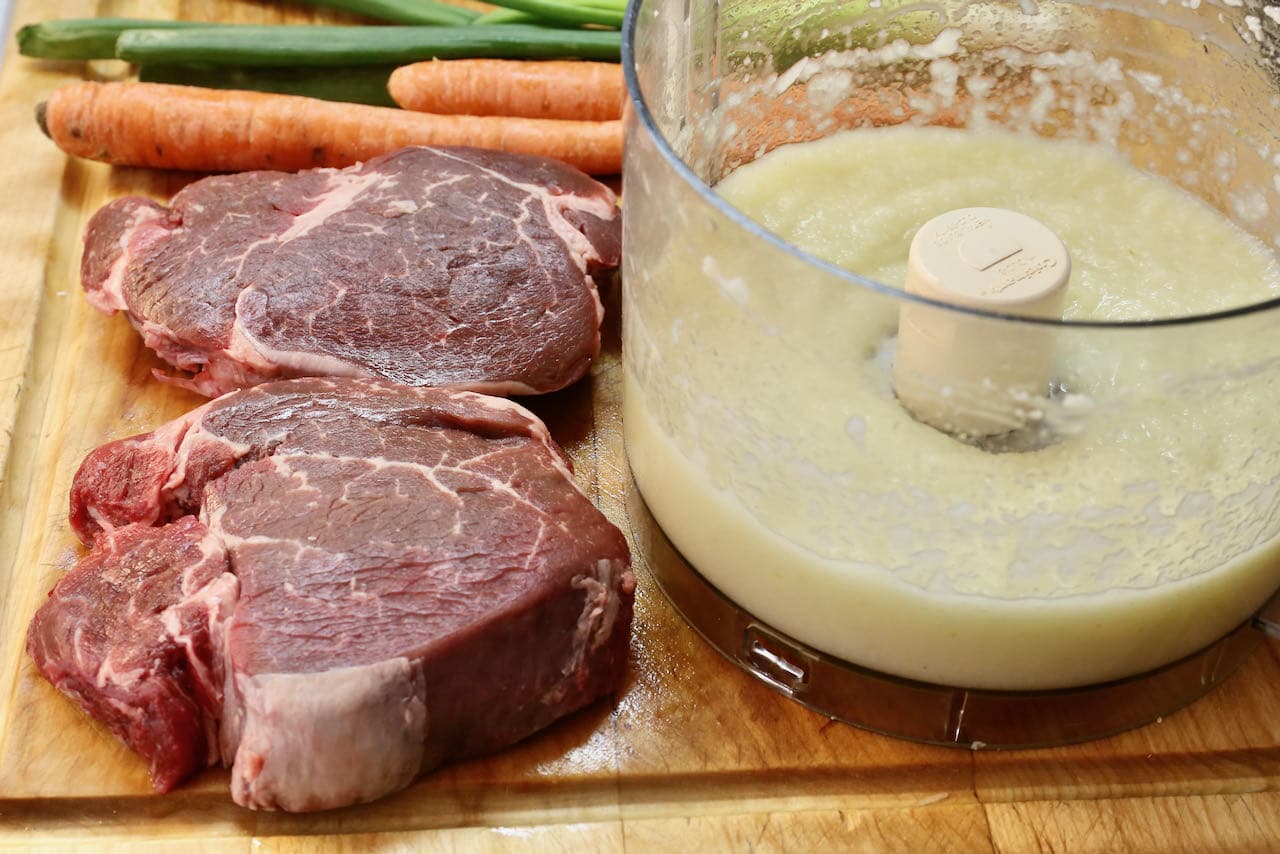
Where To Eat Beef Bulgogi Noodles
If you live in a large city in Canada or America you’ll likely have access to a local Korean restaurant that serves traditional Bulgogi Noodles.
Haven’t traveled to Korea before? It may be helpful to first sample authentic Beef Bulgogi Noodles at a local restaurant to better understand how it is served. You’ll get an idea for the ideal beef to noodle ratio, perfect portion size, and side dishes to serve at the table.
In Toronto, popular Korean restaurants that may serve Bulgogi Noodles include Doma, Korean Village Restaurant, Arisu, Charcoal and Salt, Koko Share Bar, The Owl of Minerva, Seoul Shakers, Té Restaurant, Barrio Coreano, Momofuku Noodle Bar, Tofu Village and Korea House.
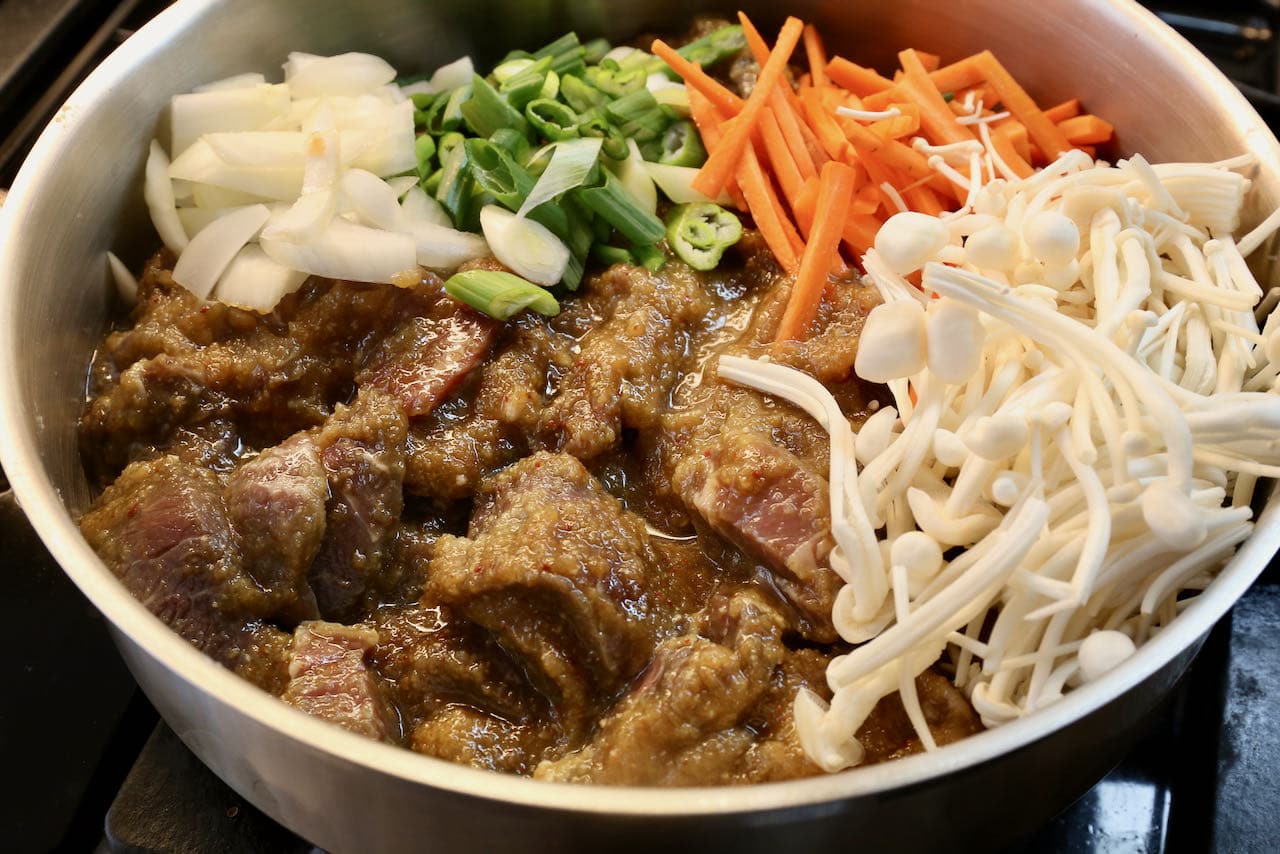
My Family Loves Korean Bulgogi Noodles
My parents flew to Asia to visit me on holiday during my 12 months in Seoul. Before landing at Incheon they visited Tokyo and Kyoto in Japan.
They had never been to a Korean restaurant at home in Toronto or Oakville before so every dish was a delight and surprise to their taste buds.
It’s no secret that my dad is a picky eater so I was a little nervous about him finding commonplace menu items like raw fish, spicy soup and fatty samgyeopsal to be unappealing.
Thankfully my parents both fell in love with Bulgogi Noodles! They ordered the dish many times during visits to Insadong and Dongdaemun. They love all sorts of noodle dishes and are big fans of juicy and tender steak.
I often make Beef Bulgogi Noodles during the colder months of the year in the Fall and Winter. After spending a day outdoors in the cold there’s no better way to heat up your chilly bones then slurping through steaming bowls of hearty Beef Bulgogi Noodles.
Your hungry (and thawing) dinner guests will be smiling from ear to ear, chopsticks on the ready!
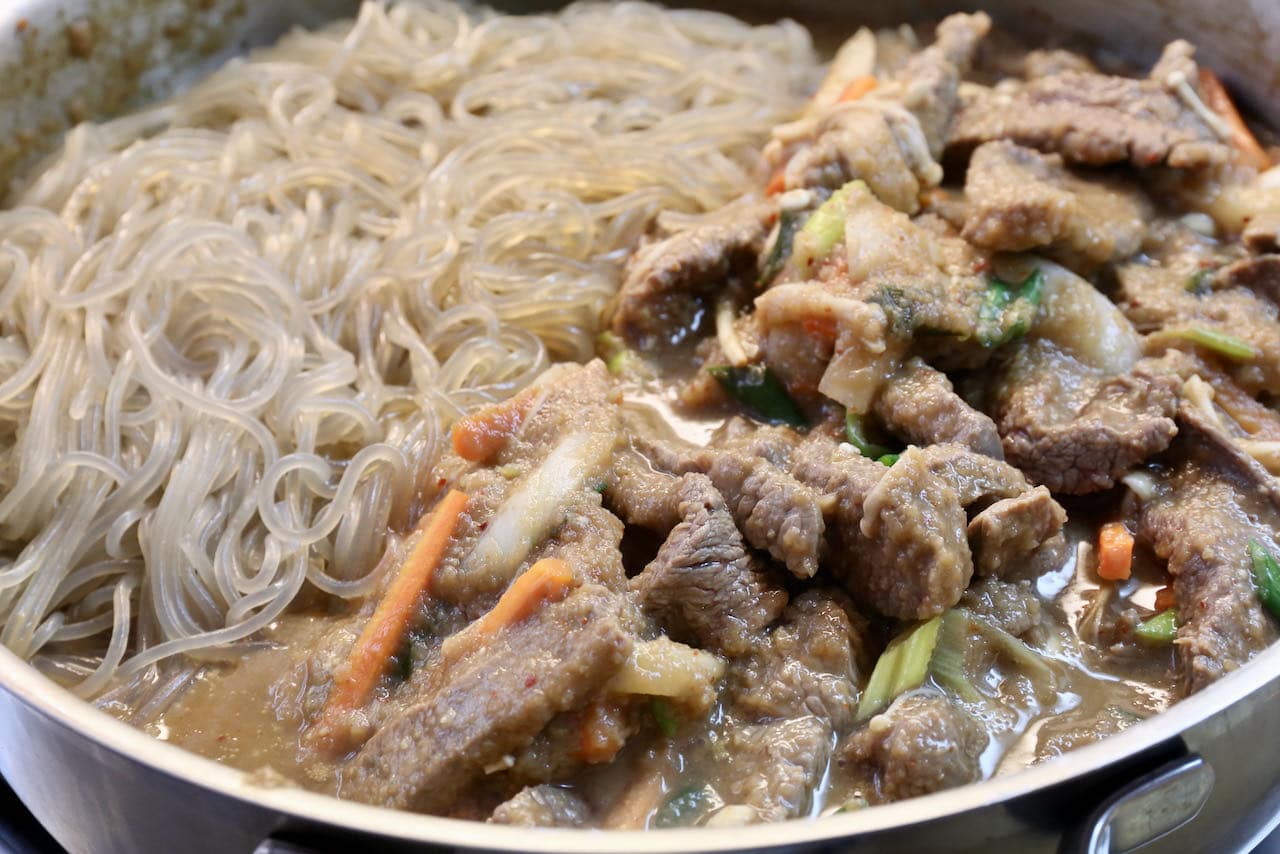
Beef Bulgogi Noodles Recipe Cooking Tips
Our Bulgogi Noodles recipe is quick and easy to make at home. We’ve included a few tips for first time Korean cooks!
- We suggest using a large Dutch Oven to avoid splatter when cooking.
- We suggest using a food processor to make the bulgogi marinade.
- You can purchase Korean Cellophane Glass Noodles at an Asian supermarket or online.
- You can purchase Korean Gochugaru Red Pepper Flakes at an Asian supermarket or online.
- We prefer using ribeye steak when preparing bulgogi as it is a fatty and tender cut of meat. You can also use tenderloin or sirloin steak.
- We’ve used pears to sweeten the marinade but you could also use apples.
- We’ve used slender enoki mushrooms in this recipe as it is traditional but you could substitute for thinly sliced button mushrooms.
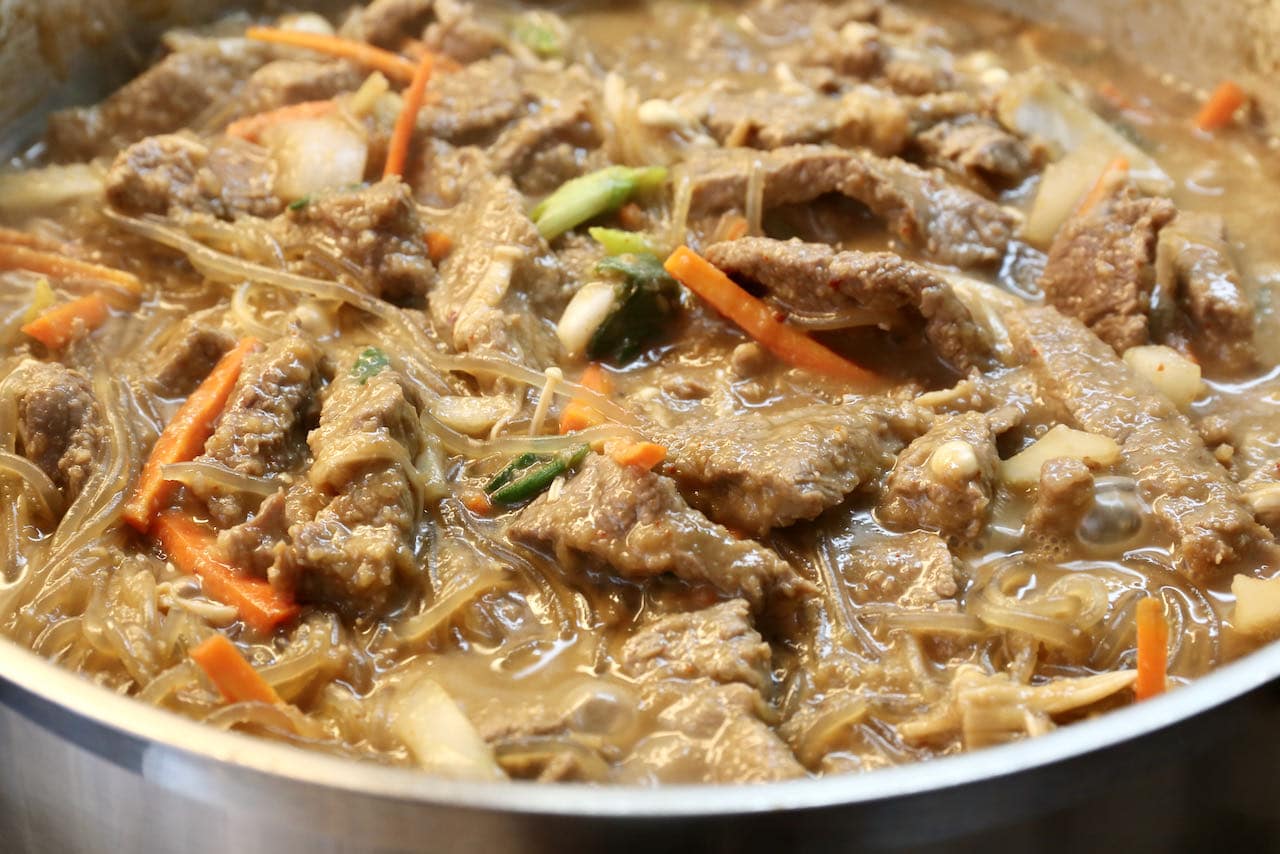
Health Benefits
Our homemade Beef Bulgogi Noodles recipe is packed full of healthy ingredients!
Onions are a humble vegetable packed with vitamins, minerals and phytochemicals. Regular consumption of onions can help boost digestive health and reduce the risk of developing heart disease.
It is only recently that scientists have begun to identify the components responsible for garlic’s myriad health benefits. Rich in phytochemicals and potassium, garlic helps boost your immune system, fight cancer and protect your heart.
Ginger contains at least 14 phytochemicals, many of which have impressive antioxidant and anti-inflammatory properties. It also has a good source of copper, which supports your bones, blood and nervous system.
Chili has been proven to help reduce the duration of sickness, prevent heart disease, and promote weight loss.
An excellent source of vitamin A and the phytochemical beta-carotene, carrots help keep your eyes and bones healthy, and may help protect against several types of cancer.
Mushrooms are rich in B vitamins: riboflavin, niacin, and pantothenic acid. The combination helps protect heart health.
Pears are rich in essential antioxidants, plant compounds, and dietary fibre. They pack all of these nutrients in a fat free, cholesterol free, 100 calorie package.
Beef is a great source of protein and minerals like iron as well as an excellent source of the amino acid L-carnitine. Beef also features antioxidant glutathione known for its anti-aging benefits.
A useful source of copper, calcium, manganese, and phosphorus, sesame seeds help support circulatory, digestive and skeletal health.
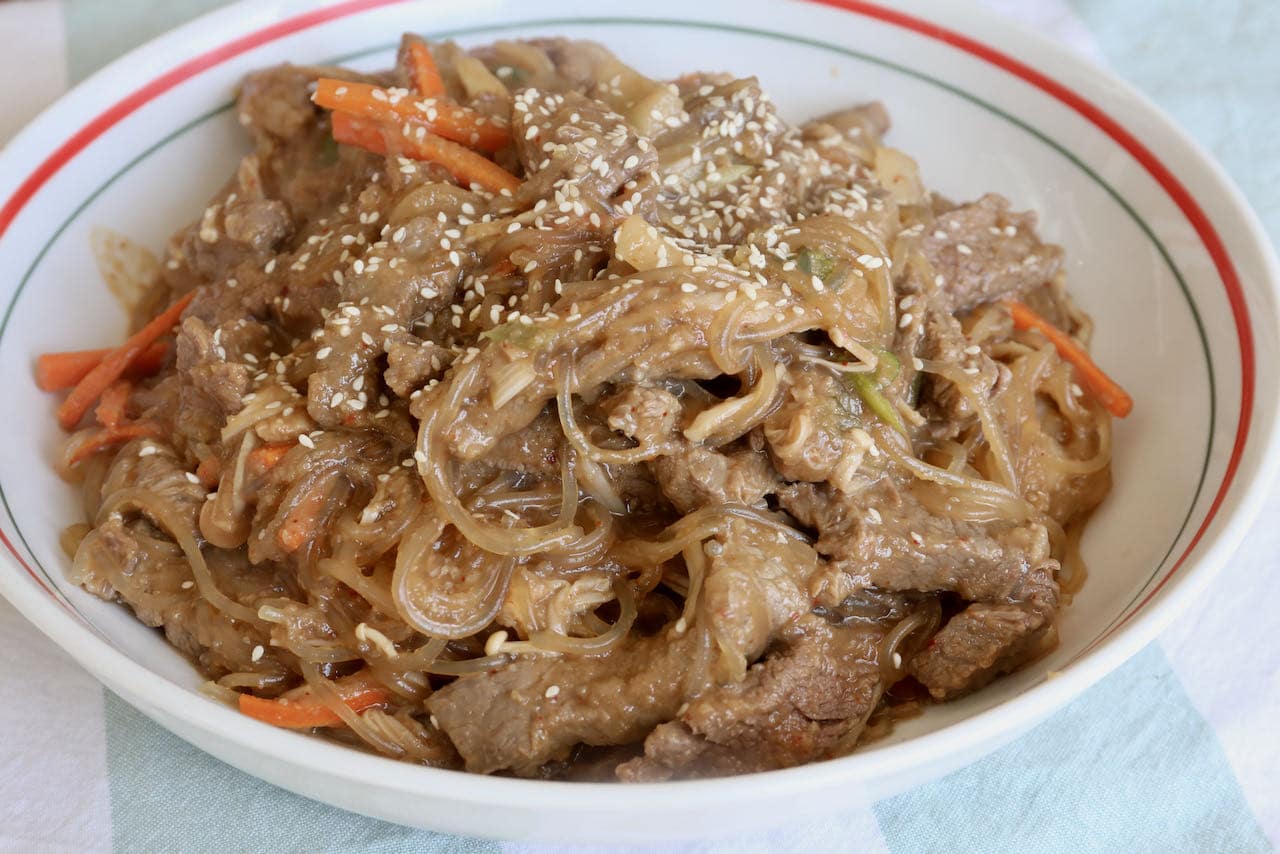
What To Serve with Beef Bulgogi Noodles
There’s nothing more comforting than cozying up to a bowl of steaming Beef Bulgogi Noodles.
We love serving this Korean noodle dish as a hearty lunch all on its own, or as part of a larger Korean dinner party menu.
If you’re hosting a Korean-inspired potluck you might like to pair our Bulgogi Noodles recipe with Gochujang Chicken Wings, Ssamjang Chicken, Spicy Gukbap Korean Rice & Beef Soup, Spicy Pork Bibimbap, or Buchimgae Buchu-Jeon Korean Chive Pancake.
After dinner why not dazzle your guests with one of our popular desserts such as Oat Flour Cookies with Chocolate Chips, Dark Chocolate Lindt Lindor Cookies, Maraschino Cherry Cupcakes Recipe, Cinnamon Babka, Blueberry Cream Cheese Earl Grey Ice Cream, Baileys Banoffee Cake, Swedish Rhubarb Cherry Pie or Skittles Sugar Cookies.
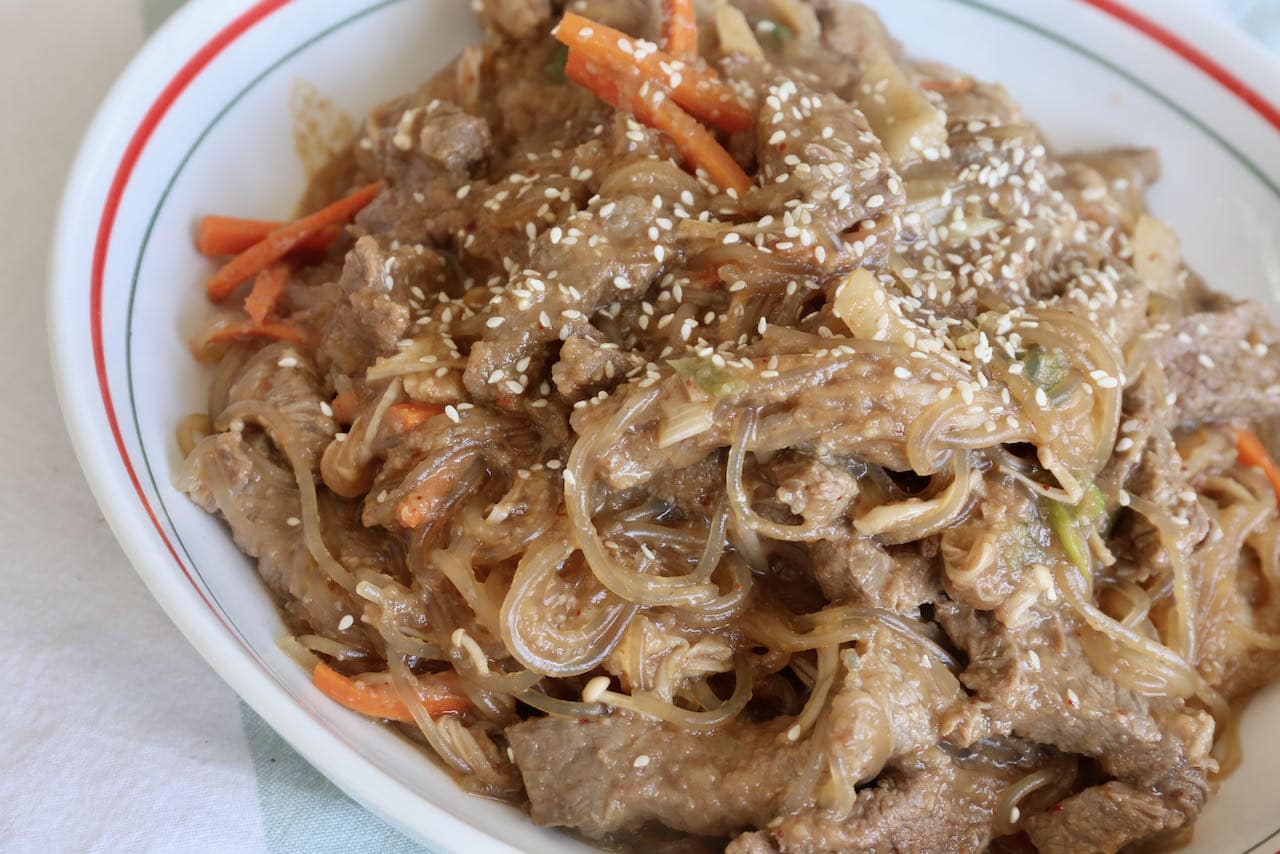
You May Also Enjoy The Noodle Recipes…
- Singapore Chow Mei Fun Noodles
- Thai Pork Rib Soup with Vermicelli Noodles
- Chicken Manchow Soup
- Healthy Tibetan Thukpa Noodle Soup
- Penang Prawn Noodle Soup Hokkien Mee
- Singaporean Laksa Shrimp & Fish Soup
- Singaporean Bak Chor Mee Minced Pork Noodle Soup
- Chinese Wonton Egg Drop Soup
- Chinese Ginger Garlic Soup Recipe for Colds
- Bun Cha Vietnamese Noodle Bowl
- Authentic Chiang Mai Noodles “Khao Soi”
- Vietnamese Grilled Pork “Bun Thit Nuong”
- Sweet and Sour Pork Meatball
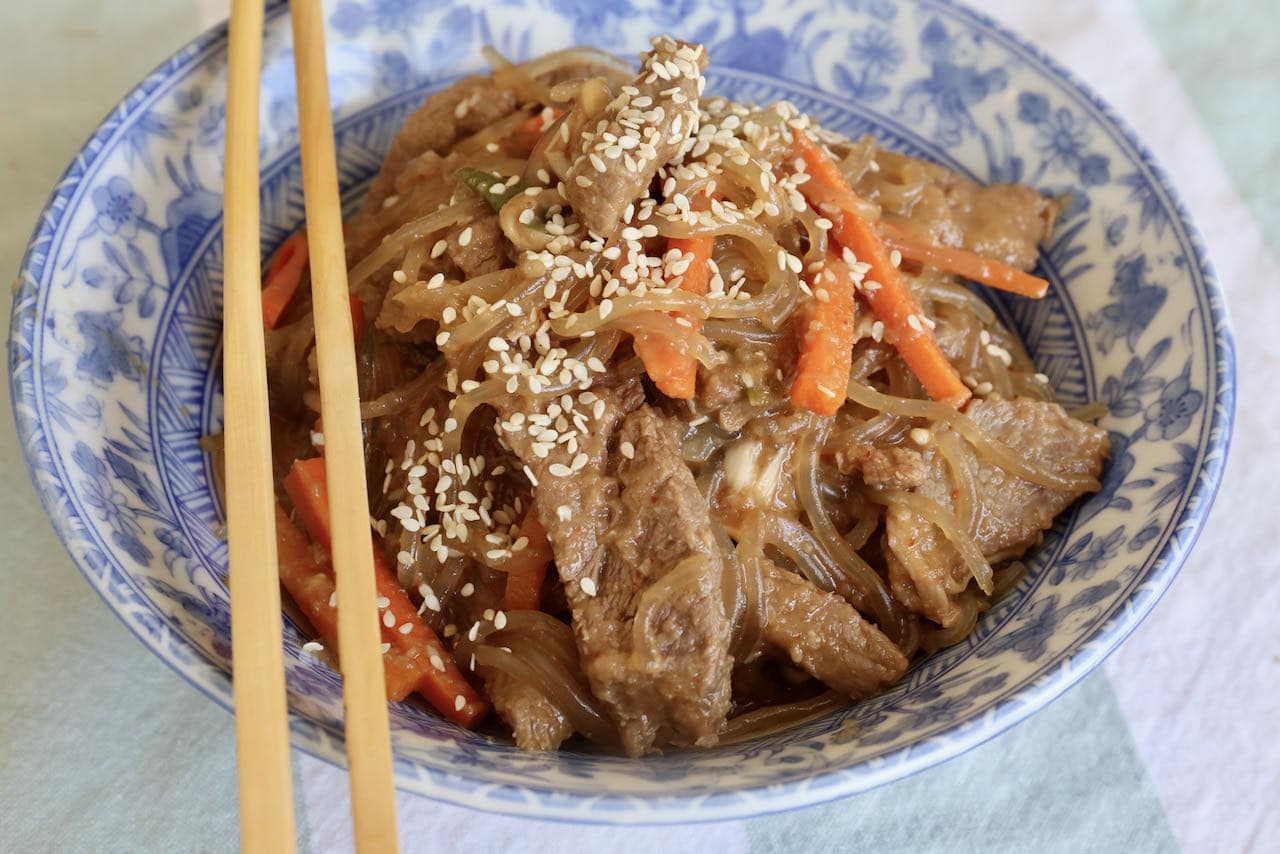
How To Make Korean Beef Bulgogi Noodles
Korean Beef Bulgogi Noodles
Equipment
- Food processor
- Mixing bowls
- French knife
- measuring spoons
- measuring cups
- Dutch Oven
- tongs
- Kitchen Scissors
Ingredients
Beef Marinade
- 1.5 lb Ribeye, Tenderloin or Sirloin Steak sliced
- 2 Pears peeled, cored, cut into chunks
- 1 Spanish Onion
- 6 Garlic Cloves
- 1 tbsp Ginger minced
- 1/4 cup Soy Sauce
- 1/4 cup Brown Sugar
- 2 tsp Gochugaru Korean Red Chili Powder
- 3 tbsp Sesame Oil
Noodles
- 200 g Korean Glass Noodles
- 2 tsp Soy Sauce
- 2 tsp Sesame Oil
Vegetables
- 6 Scallions chopped
- 1/2 cup Vidalia Onion thinly sliced
- 2 Carrots peeled and cut into matchsticks
- 1 cup Enoki Mushrooms seperated
- 1 tsp Sesame Seeds
Instructions
- Combine the pear, Spanish onion, garlic and ginger in a food processor and puree until smooth, approximately 1 minute. Transfer to a large bowl.
- Add the sliced beef and toss, using tongs to coat well. Marinate for at least 10 minutes.
- Add the soy sauce, sugar, gochugaru and sesame oil then toss together. Cover and refrigerate for at least 30 minutes.
- Bring a pot of water to boil. Add the noodles and boil for 5 minutes, until tender and chewy. Drain and rinse in cold water.
- Cut noodles a few times with a kitchen scissors and toss with soy sauce and sesame oil. Cover and set aside.
- Transfer the marinated beef, along with the sauce into a large skillet. Spread the scallions, Vidalia onion, carrot and mushrooms on the top of the meat.
- Place the skillet over high heat. When the beef and sauce starts bubbling, turn and stir the meat and vegetables with the noodles using tongs. Add marinated noodles. Cook until the beef is no longer pink and the noodles are translucent, approximately 5-6 minutes.
- Transfer cooked bulgogi, noodles and vegetables to a serving plate and serve hot. Sprinkle with sesame seeds.
Nutrition
Save this story to Pinterest!









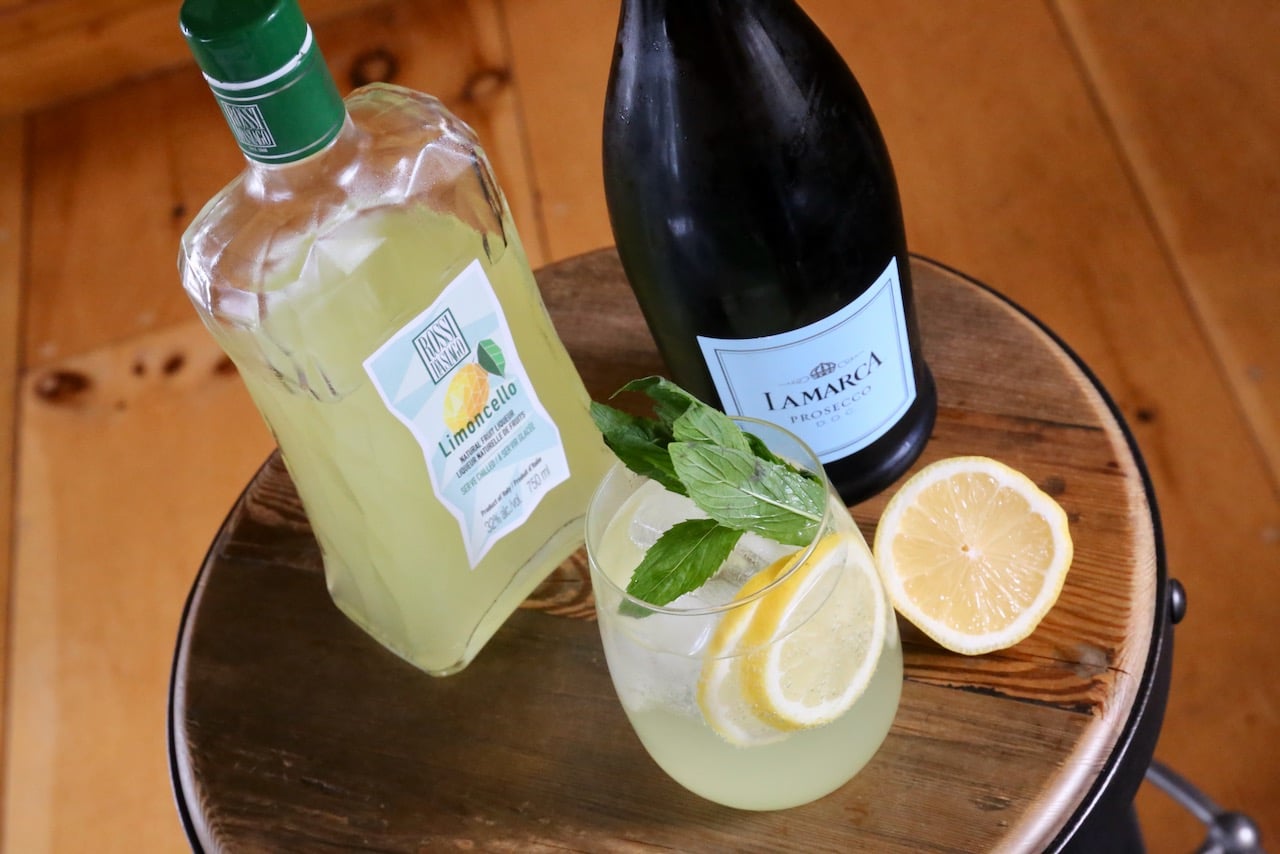
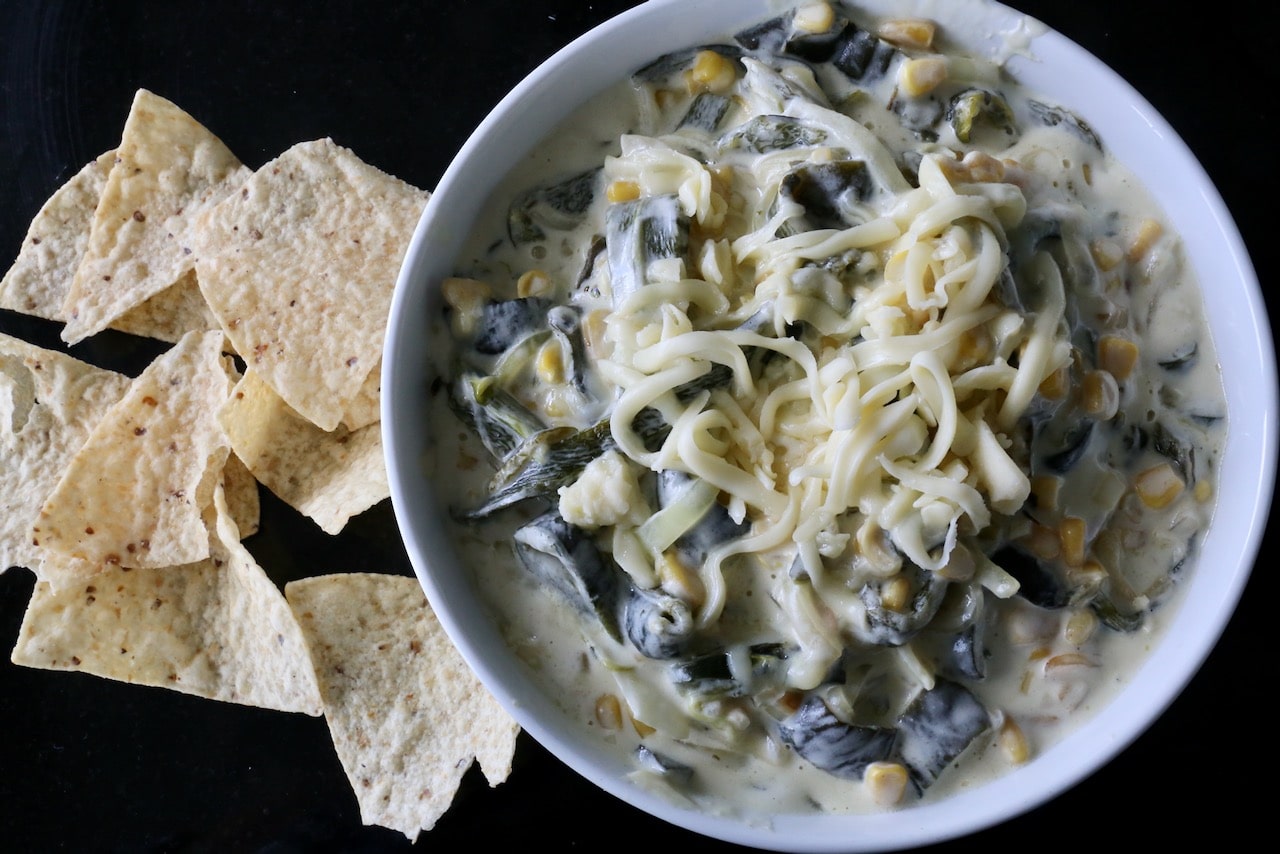
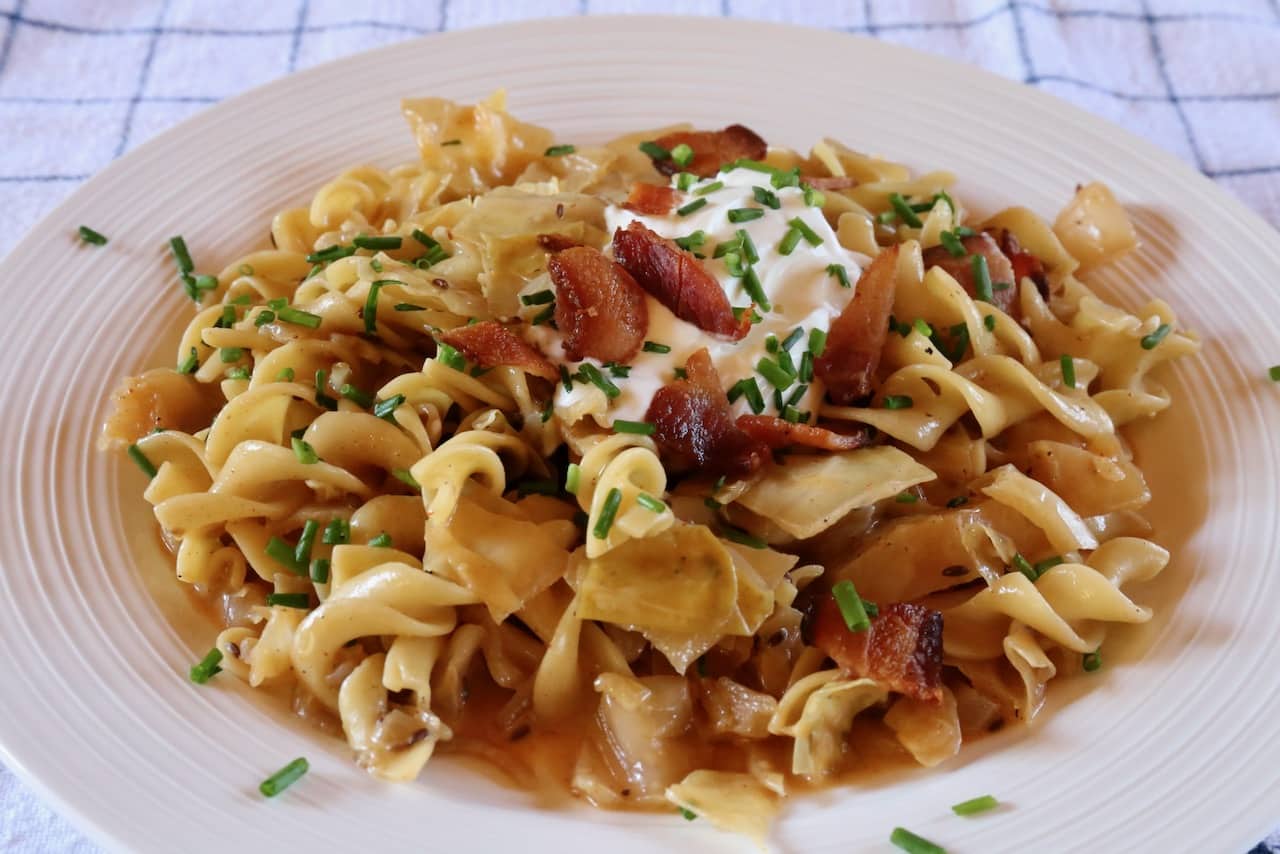
Excellent recipe. We cook Asian style dishes multiple times a week. I’ve tried a few different bulgogi recipes and this is the best sauce turnout I’ve had.
Glad you enjoyed it!